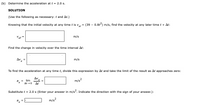Question
thumb_up100%

Transcribed Image Text:(b) Determine the acceleration at t = 2.0 s.
SOLUTION
(Use the following as necessary: t and At.)
Knowing that the initial velocity at any time t is v,
xi
(39 – 0.8t2) m/s, find the velocity at any later time t + At:
m/s
Find the change in velocity over the time interval At:
Δν.
m/s
To find the acceleration at any time t, divide this expression by At and take the limit of the result as At approaches zero:
Av
a = lim
At-0
m/s?
Δε
Substitute t = 2.0 s (Enter your answer in m/s. Indicate the direction with the sign of your answer.):
m/s?
Expert Solution
This question has been solved!
Explore an expertly crafted, step-by-step solution for a thorough understanding of key concepts.
This is a popular solution
Trending nowThis is a popular solution!
Step by stepSolved in 2 steps with 2 images

Knowledge Booster
Similar questions
- Can you use these velocity components, together with y and a = 9.8m / (s ^ 2) to obtain the time of flight, t? Write the expression. Hint: x = vot and replace t using y = 1/2 * g * t ^ 2arrow_forwardSOLVE STEP BY STEP IN DIGITAL FORMAT 14. If the speed in (m/s) that a certain athlete reaches in a 200-meter race is described by the function v(x) =-0.005x(x - 300), where x is the recommended distance. a) What distance has the athlete traveled when he reaches his maximum speed?b) What is the maximum speed he reaches?arrow_forwardPlz plz solve for all parts … God blessarrow_forward
- If we apply the above equations to the case of an object that does not change its direction of travel as it moves with constant acceleration, we find that the object: Undergoes a displacement Ax = x- x, . Note that displacement is a positive quantity if x > x, and a negative quantity if x < x,. Has average velocity v = (x - x )/t = (v + vo)/2. Note that velocity has the same sign as displacement. Travels distance d = |Ax| = |x – x,| . Note that distance is always a positive quantity. Has average speed d/t . Note that speed is always a positive quantity. Has constant acceleration a = (v – vo)/t . Acceleration may be positive or negative, depending on how velocity changes. - Xo For the case of an object that does change its direction of travel as it moves with constant acceleration, which of the quantities listed above are different? Questionarrow_forwardA ball is thrown from an initial height of 4 feet with an initial upward velocity of 29 fus. The ball's height h (in feet) after t seconds is given by the following. h-4+291-167 Find all values of t for which the ball's height is 16 feet. Round your answer(s) to the nearest hundredth. (If there is more than one answer, use the "or" button.) initial height ground - seconds O-Oarrow_forwardThe position of a particle moving under uniform acceleration is some function of time t and the acceleration a. Suppose we write this position as x=ka™t", where k is a dimensionless constant. What values must m and n have? x = kamt"arrow_forward
- solve the following exercisearrow_forwardA 2-stage rocket is fired from rest. Its acceleration data are shown in the graph below. Plot the v-t and s-t graphs describing the motion of the rocket-clearly showing the shape of the curve (or add a note) and values at inflection points. Show any calculations as well. Then find the velocity of the rocket and its elevation after 20 seconds of flight. a (m/s?) 25 18 (s) 15 20arrow_forwardA model rocket is launched with an initial upward velocity of 195 ft/s. The rocket's height h (in feet) after t seconds is given by the following. h=195t–16 Find all values of t for which the rocket's height is 87 feet. Round your answer(s) to the nearest hundredth. (If there is more than one answer, use the "or" button.) t = || seconds or O groundarrow_forward
arrow_back_ios
arrow_forward_ios